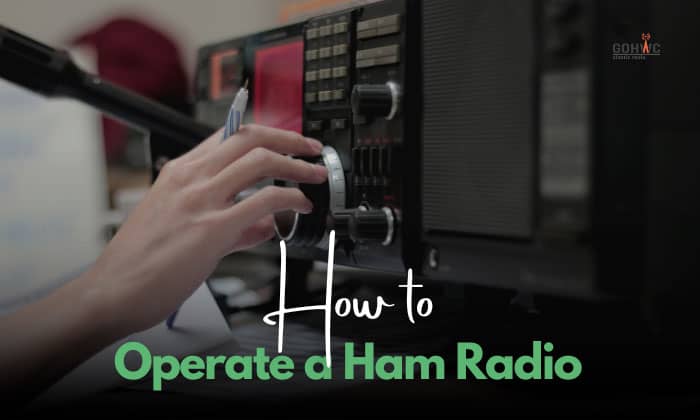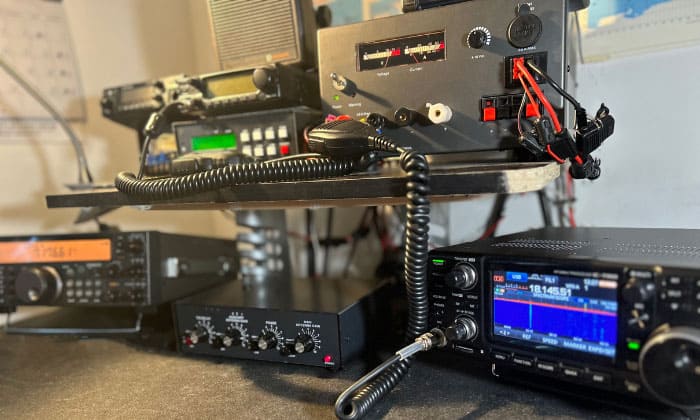Ham radio constantly changes the world by providing a unique opportunity to connect with people worldwide. However, operating a ham radio requires some radio principles and communication protocol.
So whether you are a beginner or just someone looking to get information on exploring the fundamentals of ham radio, we’ve got you covered.
This guide will provide you with a step-by-step guide on how to operate a ham radio, troubleshoot common issues, and the popular radio frequencies you can listen to.
Contents
Steps to Operate a Ham Radio
By operating a ham radio, you can connect and communicate with other amateur radio operators from different parts of the world. To help you get started, here is a beginners guide on operating a ham radio.
What you need:
- Your ham radio
- Set up kit (attenna and receiver)
- Microphone
- Power supply
Step 1: Acquire a Ham Radio License
A license is one of the ham radio basics you need before you can operate the available types of ham radios. It is what allows you to start your ham radio operation. However, the requirements vary depending on region/country.
Some of the common types include:
- A General License. If you’re interested in global communication, this license is for you. It provides access to more frequencies, but you’ll need to pass a written technician exam and answer 35 questions.
- Technician License. This type of license is what you will require to learn ham radio, as it allows acess to 30MHz and higher radio frequencies . This test also has 35 questions mostly on radio operating practices, radio theory, and user regulations.
- Amateur Extra Radio License. The Amateur license allows you all the privileges of operating an amateur radio. This exam has 50 questions.
Step 2: Install Your Equipment
To install your ham radio equipment, there are several things you need to do:
1. Plug the microphone into your ham radio.
2. Then, connect the radio to your power supply to turn it on.
If you experience any issues, refer to the user’s manual.
3. You might need a beginner ham radio kit, which typically includes an antenna and a receiver to access a broader range of stations and personalize your radio features. To simplify the installation, here is a setup diagram.
Antenna→Transceiver→Power Supply
4. Now locate the power switch on either the back or front of the radio unit and toggle it. When your radio is ready, a light that illuminates or changes color might appear.
Step 3: Choose Your Operating Frequency
To use a ham radio, you have to choose your operating frequency. Here, you have two primary options, and these two frequency ranges influence how far ham radio can reach. However, the ham radio base station set up is also key.
- Very High Frequency (VHF) – This ranges from 30 to 300MHz, with a ham radio band from 144 to 148MHz. This option can resist noise and provide reliable transmission. Besides, it allows communication between two ham radios.
- Ultra High Frequency (UHF) – On the other hand, the Ultra High Frequency ranges from 300MHz to 3GHz and has a shorter wavelength. It is more vulnerable to interference compared to VHF. However, the frequency you choose depends on the privileges of your license.
Step 4: Make a Call and Engage in the Conversation
To make a call, you need to follow the established protocol. Start by announcing your call sign. Follow it up with the call of the station you want to contact.
Make your call and be ready for anyone to answer your call. If the call is not answered, you can try again.
To engage in a conversation, you need to have good communication techniques.
If someone picks up your call, keep your conversation short and friendly.
Step 5: Sign off
Sometimes, operating ham radio for beginners requires you to keep calm. You don’t have to participate in every active conversation.
Signing off is as important as starting. Pay attention to radio protocols. You can signal that you are closing a talk with “Best Regards”.
FAQs
Troubleshooting Common Issues
As a ham radio user, you may encounter issues, such as operational problems, radio frequency issues, and power outages. Here is a detailed explanation of how to troubleshoot each of these problems:
1. Operational Problems
Operation issues are very common with Hams radio. Sometimes, an operator may forget to switch on the system or even forget the call sign.
Electrical devices can also be a hindrance. Devices such as computers, microwaves, or even smartphones can cause interference to ham radio.
You could use the old trial-and-error method to troubleshoot the issue. Move each item at a time to discover the error, or refer to the ham radio guide.
2. Radiofrequency Issues
Missing cables, bad connections, or a defective antenna are common problems associated with radio frequency. To troubleshoot this issues, you might need to:
- Replace the missing cables
- Inspect the antenna feed lines to check the connection
- Check the combination of antennas that seem to work and those that do not.
3. Power Problems
Power issues can be difficult to detect. Even if the power supply light is on, it doesn’t necessarily mean that the output is at the correct voltage. Still, poor connections can be an issue. Try these solutions to troubleshoot common power problems:
- Check the voltage output volume
- Find the meter ranges of both AC and DC
- Measure power voltage, especially if you suspect a poor connection
Popular Ham Radio Frequencies to Listen to
Ham radio is diverse, and choosing the popular frequency bands to listen to can be challenging. The popularity of specific frequencies can vary depending on location, events of the day, or the time.
Aside from the survivalist ham radio, here are some of the most popular ham radio channels you can to listen to:
- 337MHz
- 775MHz
- 430MHz
- 90MHz
- 160MHz
- 4742MHZ
- 500MHz
- 50MHz
- 144MHz
- 550MHz
What is the handheld ham radio range?
The typical range for your basic handheld ham radio design is about 5 miles. It can extend further up to 10 miles for high-powered devices.
Conclusion
Learning how to operate a ham radio enhances both your communication and listening skills. Just remember, you don’t need a license to listen to ham radio, but you need one to operate it.
Get a license that suits your target and the right equipment, and operate your ham radio stress-free. Keep in mind that while there are various popular channels to listen to, popularity depends on factors such as location, events, or time.

Hello! I am Hart, the content writer and editor here at G0HWC. I used to be in the same local radio club with Howe, and he convinced me to join him in spreading my love for the radio with others. With a background in radio studies, I spend every day crafting accurate, easy to read content on various topics related to owning and using radios. I hope that my content can help you confidently venture in your radio journey!







